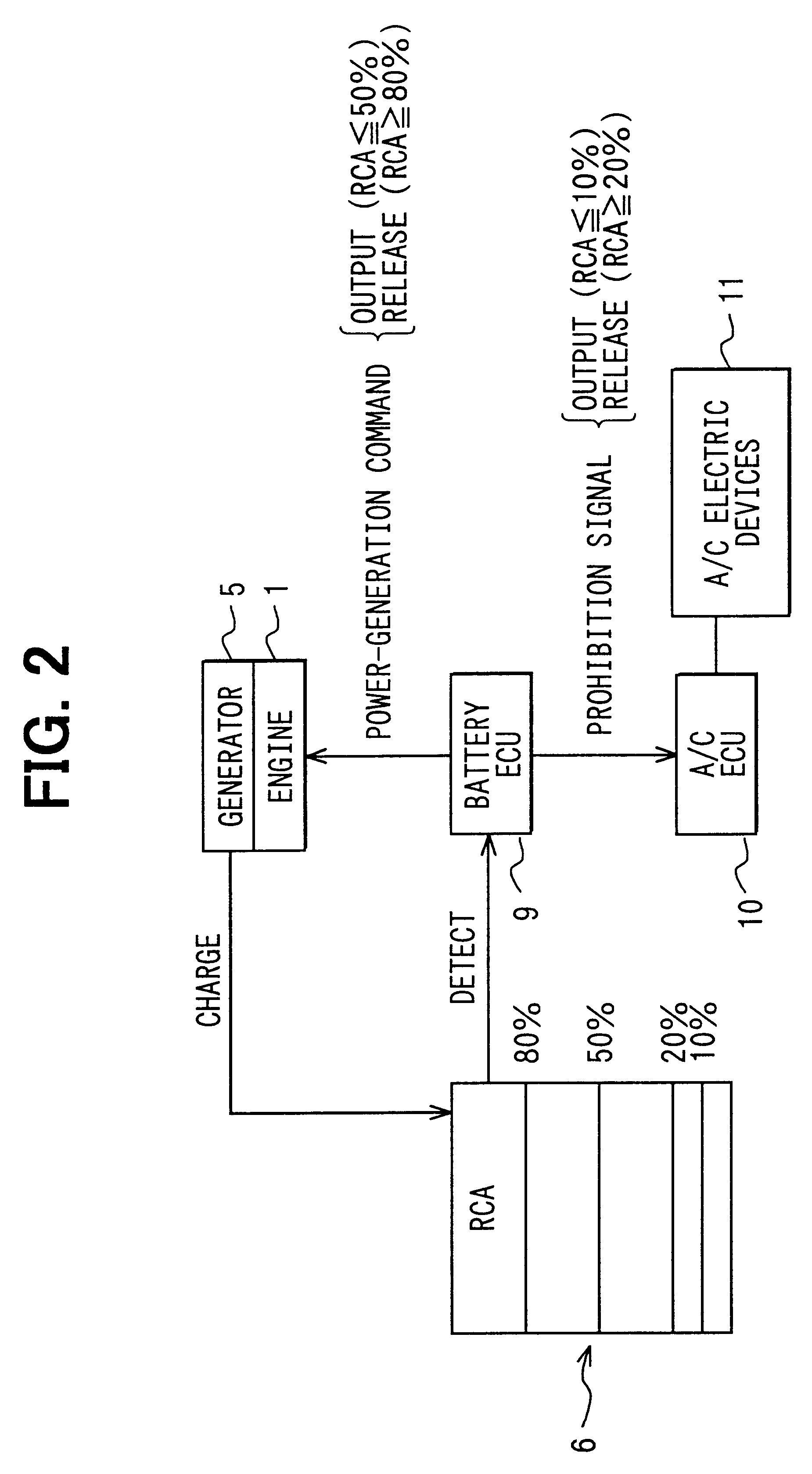Charging control system for air conditioner and battery
a technology of charging control system and air conditioner, which is applied in the direction of secondary cell servicing/maintenance, electrochemical generator, safety/protection circuit, etc., can solve the problems of not specifically revealing a method for electrically controlling the other various electrical devices, affecting the rechargeable amount of the battery, and not rapidly increasing the power consumption of the plural air-conditioning electrical devices
- Summary
- Abstract
- Description
- Claims
- Application Information
AI Technical Summary
Benefits of technology
Problems solved by technology
Method used
Image
Examples
first embodiment
the present invention will be now described with reference to FIGS. 1-3 and 4A-4F. In the first embodiment, the present invention is typically applied to a hybrid vehicle. As shown in FIG. 1, the hybrid vehicle includes both of an engine (internal combustion engine) 1 and a motor (electrical driving motor) 2 as a driving source for driving the vehicle.
A motive-power switching mechanism 3 is disposed to switch a motive-power transmission state, among a transmission state from only the engine 1 to a vehicle shaft 4, a transmission state from only the motor 2 to the shaft 4 and a transmission state from both of the engine 1 and the motor 2 to the shaft 4. A generator 5 is connected to an output shaft of the engine 1, and is rotated by the engine 1 to generate electrical power. A main battery 6, for driving the vehicle, is charged by the generator 5, and supplies electrical power to the motor 2. Because the main battery 6 is for supplying electrical power to the driving motor 2, a charg...
second embodiment
the present invention will be described with reference to FIGS. 5A-5F. In the second embodiment, when the output of the air-conditioning prohibition signal is stopped, the plural air-conditioning electrical devices are started at the same time. At this time, each of the air-conditioning electrical devices are is started by a small operation level. Thereafter, the operation levels of the air-conditioning electrical devices are gradually increased toward the necessary air-conditioning levels required from the air-conditioning function in the passenger compartment, respectively.
Specific control operations according to the second embodiment, shown in FIGS. 5A-5F, are performed at step S90 shown in FIG. 3. In the second embodiment, FIG. 5A shows a control operation of the front interior blower 16, FIG. 5B shows a control operation of the rear interior blower, FIG. 5C shows a control operation of the compressor 27, FIG. 5D shows a control operation of the exterior blower, FIG. 5E shows a ...
third embodiment
the present invention will be now described with reference to FIGS. 6A-6F. In the third embodiment, the different start-timing control according to the first embodiment and the start operation-level control according to the second embodiment are combined with each other. FIG. 6A shows a control operation of the front interior blower 16, FIG. 6B shows a control operation of the rear interior blower, FIG. 6C shows a control operation of the compressor 27, FIG. 6D shows a control operation of the exterior blower 31, FIG. 6E shows a control operation of the electrical water pump 36, and FIG. 6F shows a control operation of the electrical heater 20.
Specific control operations shown in FIGS. 6A-6F according to the third embodiment are performed at step S90 in FIG. 3, for example. When the passing time "t" is 3 seconds, the front interior blower 16 is started as shown in FIG. 6A. When the passing time "t" is 4 seconds, the compressor 27 is started as shown in FIG. 6C. When the passing time...
PUM
| Property | Measurement | Unit |
|---|---|---|
| charging voltage | aaaaa | aaaaa |
| voltage | aaaaa | aaaaa |
| specific gravity | aaaaa | aaaaa |
Abstract
Description
Claims
Application Information
 Login to View More
Login to View More - R&D
- Intellectual Property
- Life Sciences
- Materials
- Tech Scout
- Unparalleled Data Quality
- Higher Quality Content
- 60% Fewer Hallucinations
Browse by: Latest US Patents, China's latest patents, Technical Efficacy Thesaurus, Application Domain, Technology Topic, Popular Technical Reports.
© 2025 PatSnap. All rights reserved.Legal|Privacy policy|Modern Slavery Act Transparency Statement|Sitemap|About US| Contact US: help@patsnap.com



